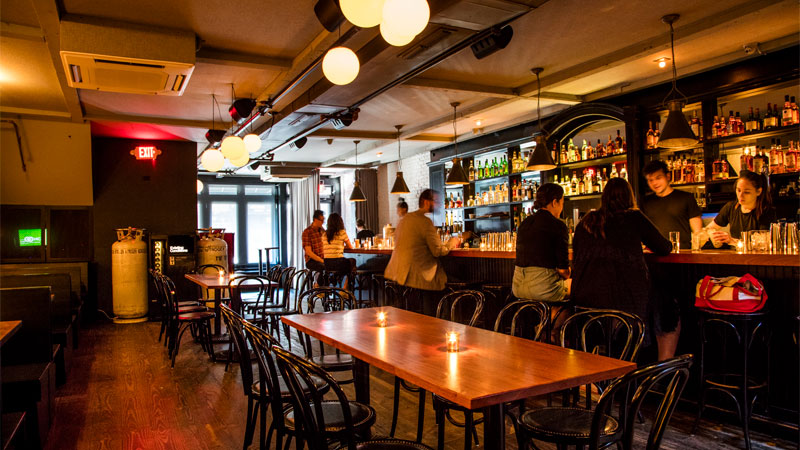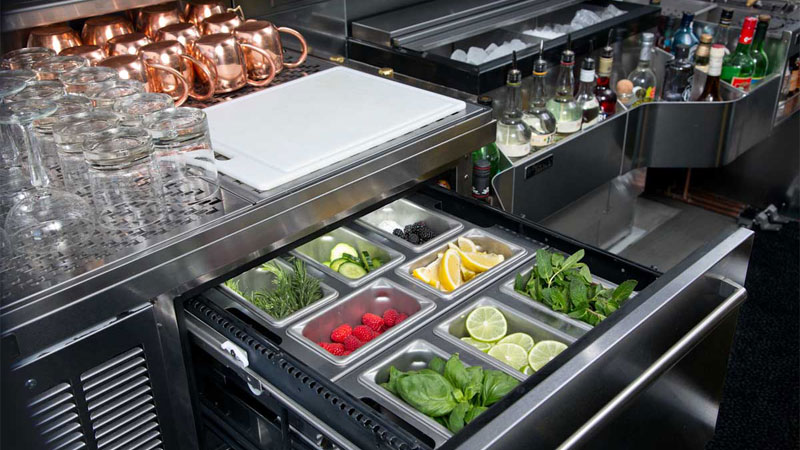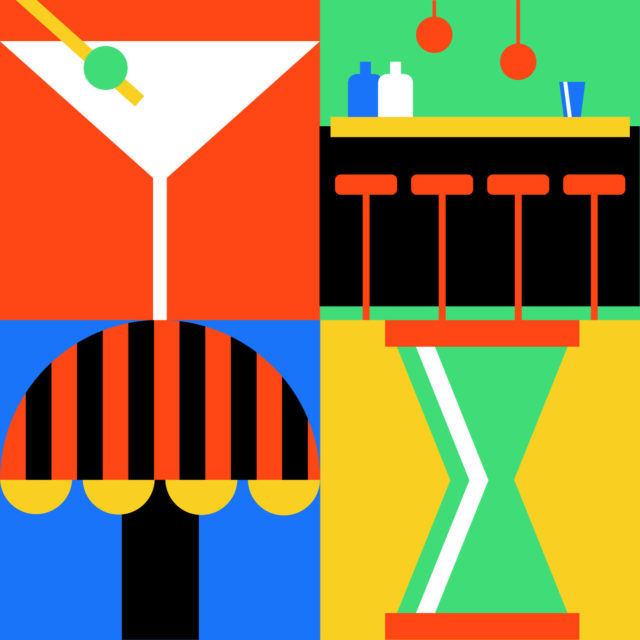When opening a new bar, design is a critical element. The way the bar looks and feels helps set the tone for the guest experience — but it’s not all about the aesthetics. A bar needs to be functional, too.
The ambience of the space as a whole must be considered, including the relationship between the music, lighting, floor layout, seating, and the customizations that’ll make the bar special. There are also practical elements that should be taken into account, from the equipment that’ll be used to the foundational infrastructure that’ll ensure the bar is up to code from a legal perspective.
Designing a bar is no easy task — and flaws can significantly affect both workflow and revenue, but certain design strategies can help set a new bar up for success. Here, some of the drinks industry’s most well-established designers and bar professionals weigh in on the essentials for designing the optimal bar.
Know your concept.
You wouldn’t buy a two-bedroom home in the suburbs for your family if you have five children, so why would you build a bar with one bar station if you plan on serving 500 to 1,000 guests a night? Before diving into the design process, you need to get an understanding of how much space will be needed to accommodate your beverage program.
“Define the program’s ambition,” says Devon Tarby, a partner at Proprietors LLC in Los Angeles. In addition, you’ll need to consider the number of cocktails, the style of the drinks, the spirit offerings, and other key details like what your clientele and volume will look like. “This,” she says, “will trigger very specific equipment needs, be it dedicated freezers for glassware and specialty ice, custom work surfaces, refrigeration, ice well size, sink locations, ice machine selection, and dedicated prep space.”
Tarby also says it’s important to analyze the bar’s overall space, including the number of seats, the size of the bar itself, its hours of operation, labor constraints, and projected sales. “This will dictate the number of stations needed to adequately service the restaurant or bar and, generally, will require some back-and-forth with designers and architects on the bar’s size and shape.”

Curate a cohesive ambience.
Authenticity is what guests will notice — and that’s what will resonate with them. One of the reasons that tiki bars are so popular is because of the escapism they offer through their kitschy design, music, staff uniforms, and tropical drinks.
Tobin Ellis, a bar designer and the proprietor of the design company BarMagic in Las Vegas, says he once heard that “you shouldn’t notice great design; you should just feel warmly wrapped up in it.” In other words, he says, “Don’t try to be ‘designy’ and get your designs noticed. Instead, try to help the owners tell their story. Bring it to life, remembering that at the core of what’s being built will be human connection and hospitality. It’s about people, not wallpaper and ironic neon signs.”
A big piece of curating the bar experience, says Don Lee, a co-owner of Existing Conditions in New York, is striking the right balance with lighting and music. “Two important factors for me when thinking about the ambiance of a space,” says Lee, “are the sound (speaker placement, sound proofing, etc.) and lights (lighting for guests at the right brightness, color temperature, and having proper illumination of working areas).”
Ellis says that it’s helpful to have “one clearly communicated vision that either embraces the building, space, or neighborhood — or you need to do the exact opposite [and] design something that completely takes people out of that culture and magically transports them somewhere else in time or space.” As he points out, hospitality is a form of theater. “Great theater requires a willing suspension of disbelief, which means the guest walks in and says, ‘Yes, I buy into this fictional story you’re telling here, and I love it!’ So the devil is, of course, in the details. Right down to the acoustical design, lighting plan, reflected ceiling plan, and so much more.”
Know when to be conservative with funds, and where to splurge.
It’s easy to get carried away with fancy tools and aesthetically pleasing design details, but they can burn through your budget fast, which isn’t ideal, especially if you run into any hiccups down the road. “Always be conservative,” says Lee, “but spend money on the things that you can never move once things are built. For example, if once the bar is built you can’t move the lowboy refrigerators, then you should buy quality lowboys.”
Any bar owner who’s had to replace such hefty, crucial equipment will second that statement — quality storage behind the bar is essential for bar efficiency. Tarby recommends Glasstender as an equipment brand worth investing in.
“You should splurge on sinks and customization,” says Leo DeGroff, a New York-based bar designer and consultant. “I would be conservative with sprayers because there are additional plumbing costs.” DeGroff warns that over-ordering opening liquor inventory is a popular mistake. “Never take advantage of case deals or shutdowns for an opening order,” he says.
In many cases, the direction of a bar program will change once sales, guest feedback, and other factors can be assessed. Plus, sometimes the drinks that you expect to sell well, don’t. “Stagnant liquor inventory has absolutely no cash value,” adds DeGroff. “You can buy it almost anytime.” He also suggests keeping your liquor par as low as possible with just “the bare minimum of liquor you need to stock every well, shelf, and backup liquor storage. Start at that number and trim where you can.”
Toree Gotsis, a bar and beverage specialist at Apex Commercial Kitchen Co. in Eden Prairie, Minn., suggests splurging on making the bar area larger to meet the demands of the menu and seating capacity. “Long ticket times are not only frustrating for the guests, but also for the bartender who is constantly drowning, trying to keep up with drink orders,” she says. “An unhappy bartender is not going to make for a great guest experience.” Gotsis also recommends making sure the bar is large enough to accommodate both the number of bartenders who will be working during peak hours and appropriate-sized equipment for stocking ingredients and products for the busy periods.

Hire experts where needed.
Opening a bar is no cheap feat; we all know that. But another place where splurging is worthwhile is when experts are needed for executing high-level tasks like design. “Your job as a bar owner is to understand the business of selling and serving drinks,” says Ellis. “It isn’t to attempt to become an architect, designer, contractor, or consultant. There’s no piece of software a novice can learn in a week — or even a month — that can be used [for] construction drawings, so don’t waste time or money trying to do the job of a designer.”
This advice may seem like common sense, but many bar owners fail to follow it. Working with experts and designating clear roles and responsibilities during the design process are crucial for a bar’s success. “If you draw something in [Google] SketchUp, a professional is still going to have to sit down and redraw it all in AutoCAD or Revit,” says Ellis. “The design build industry uses complex software that requires an incredible knowledge of compliance, life safety, engineering, and more.” He points out that nobody learns design or professional programs, like ArchiCAD, AutoCAD, AQ Designer, Revit, and other BIM software, at this level as a hobby. “There is far too much training required [that goes] well beyond how to ‘draw,’ which is why these professionals in most cases are required to be licensed in the state [where] they work in order to stamp construction documents.”
Plumbing is another important aspect of the build-out that requires a specialist. Lee expresses regrets over previously having hired a contractor to do the work of a plumber, adding that it’s a mistake he won’t make again. While there may be the initial sticker shock of hiring experts for these jobs, bar owners say it will save you headaches and money in the long run, so it’s better to do things the right way from the start.
Don’t overlook the importance of sinks.
Each of the professionals interviewed for this article stressed the importance of sinks behind the bar. Though they’re necessary for efficient service and being able to effectively reset the bar, they aren’t always given enough thought.
“The mandate that every bar station have at least one deep-basin sink per ice bin is critical — ideally a two-basin sink,” says Tarby. “In testing, we’ve found that it isn’t the speed of making cocktails that has the biggest impact on revenue; it’s the ability for the bartender to reset between rounds and begin the next.” Having a sink to dump ice in after shaking and quickly cleaning tools, she says, is paramount for any serious cocktail program. “We’ve begun integrating other tools to speed up the process even more, [such as] glass rinsers at each work surface and foot pedals on sinks.”
Ellis has a similar view. “The biggest thing I see omitted the most often is a lack of dump sinks behind a bar,” he says. “Where do you make drinks at home? I’ll bet it’s in the kitchen. Because that’s where the refrigeration, sink, and garbage are. Bartenders make a lot more drinks in a commercial bar than you make in your kitchen, so it’s insanity that every single bar station does not have its own dump sink.”

Employ design that makes the bartender’s job easier.
Gotsis says bar owners should do their research before beginning the design process. “Drink menus have a huge impact on what equipment should be incorporated,” she says. “The bar industry is evolving creatively and technically, [and] we have to make sure that bar designs [and] builds are keeping up with those trends for the sake of the people working in the trenches.”
Bar design plays a crucial role in a bartender’s ability to perform at their best and make money for the bar. “Imagine two office workers sharing one phone, taking turns on one keyboard,” says Ellis. “It’s laughable, and yet that’s what happens behind almost every bar in the world. Bartenders have to run around and share critical pieces of equipment that they use hundreds, even thousands, of times per shift. It’s absolute madness.”
Any unnecessary movements to access certain ingredients or tools can eat away at the speed a bartender is able to make and serve drinks. “The best single bit of advice I can give anyone designing a bar comes from my own personal zero-step bartending philosophy,” says Ellis. “If I’ve done my job well as a bar designer, 80 percent or more of what each bartender needs to do their job is within arm’s reach — or maybe a lean or pivot.” He emphasizes that there’s no walking in smart bartending. “Nobody wins when bartenders are doing laps behind the bar.”
